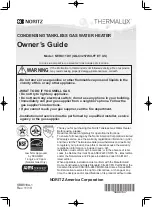
English
6
MAINTENANCE:
PRECAUTIONS TO BE TAKEN WHEN THE APPLIANCE IS NOT TO BE USED
FOR A PERIOD OF TIME: Always keep the heater area clear and free from
combustible materials, gasoline and other flammable vapors and liquids. Store
heater when it has cooled in a zippered bag or other sealed dust free location
between uses. Keep the vent areas (slots in the bottom and the top at the
front of heater) clear at all times. Visually inspect the pilot flame and burner
periodically during use. The pilot flame should be blue in color (not yellow) and
will extend beyond the thermocouple. The flame will surround the thermocouple
just below the tip, see Figure 6. A slight yellow flame may occur where the pilot
flame and main burner flame meet. The burner should be bright orange (with
a slight blue color around the border, a red-orange haze that is visible on the
ceramic tile is acceptable) and without a noticeable flame. A blue flame that
rolls out at the top of the ceramic tile indicates an accumulation of dust, lint or
spider webs inside the casing assembly and main burner assembly. If the pilot is
yellow or the burner has a noticeable flame, cleaning may be required. Use the
following procedure to inspect the casing assembly and main burner assembly.
It is necessary to periodically check the burner orifice and burner venturi tube to
make sure they are clear of insects/ nests or spider webs that may accumulate
over time. A clogged tube can lead to a fire.
1. Allow heater to thoroughly cool before performing any maintenance.
2. Remove cartridge from heater or turn OFF gas supply at remote cartridge valve, and
disconnect hose from heater.
3. Remove (4) four screws that secure the rear cover to the Heater.
4. Pivot cover outward from bottom. Release from 2 top clips. Set aside.
5. Remove (4) four burner retaining screws and
fuel line from burner assembly. Remove burner
assembly from back of housing.
6. Inspect interior of casing assembly for
accumulation of dust, lint or spider webs. If
necessary, clean interior of casing assembly with
a vacuum cleaner or apply air pressure. Do not
damage any components within casing assembly
when you are cleaning.
7. Inspect and clean main burner orifice (threaded
into orifice holder). Orifice holder is attached to the
burner assembly venturi with (2) two screws.
8. Inspect and clean pilot (mounted to bracket) by using a vacuum or apply air pressure
through the holes in the pilot indicated by the arrows in Figure 6. WARNING: Never use
needles, wires, or similar cylindrical objects to clean the pilot to avoid damaging the
calibrated orifice that controls the gas flow.
9. Apply air pressure (max. 30 psi.) into ceramic tile of burner assembly and the venturi
tube to remove dust, lint or spider webs.
10. Reassemble main burner orifice holder onto the burner assembly.
11. Reinstall burner assembly into the heater housing
12. Reinstall fuel line and check for leaks.
13. Install heater back cover.
TROUBLESHOOTING INFORMATION:
IF SPARK ELECTRODE DOES NOT PRODUCE SPARK, CHECK
• Spark electrode broken – replace ODS (Oxygen Depletion Sensor).
• Igniter wire may not be attached to spark electrode, ground wire may not be
attached to frame - attach.
• Igniter wire damaged – replace.
• Piezo igniter defective – replace gas valve ass’y.
IF SPARK ELECTRODE PRODUCES SPARK BUT PILOT DOES NOT LIGHT, CHECK
• No gas to heater – install disposable cartridge or connect hose and turn on valve at
remote cartridge.
• “PILOT” position not properly aligned – turn gas control knob to “PILOT” position and
depress.
• Pilot is blocked from spider web or dirt – clean pilot, see MAINTENANCE.
IF PILOT FLAME DOES NOT STAY LIT WHEN KNOB IS RELEASED, CHECK
• Control knob in “PILOT” position not completely depressed or held in long enough to
purge air from lines.
• Pilot flame not surrounding thermocouple – clean pilot, see MAINTENANCE.
• Pilot Assembly defective – replace.
• Tip switch wires disconnected – connect.
IF MAIN BURNER DOES NOT IGNITE, CHECK
• Main burner orifice is blocked - clean burner, see MAINTENANCE.
IF HEATER KEEPS SHUTTING “OFF” DURING NORMAL OPERATION, CHECK
• Pilot is blocked – clean pilot, see MAINTENANCE.
• Provide minimum fresh air opening of 9 square inches (15.24 square centimeters)
(example 3” (7.62 cm) x 3”(7.62 cm) opening).
• Tip over switch activated from bumping heater. Re-light
• Regulator defective - Replace regulator.
• Internal contamination - Replace control valve and regulator.
• Call Technical Services for additional information.
PILOT FLAME
OXYGEN DEPLETION
SENSOR
Figure 6: ODS, PILOT, ASSEMBLY







































